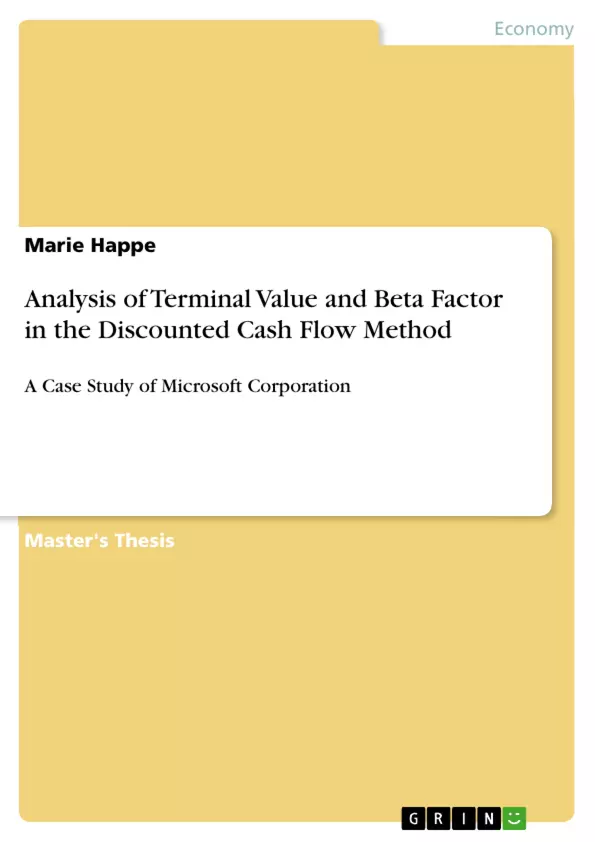Company valuation is requisite to identify the deviation of the intrinsic value of an asset from its market price. The Discounted Cash Flow method is a frequently used method to determine intrinsic value. It determines the intrinsic value based on the discounted future cash flow of the asset and works in two stages. The first stage refers to an explicit forecast of the cash flow followed by the second stage which captures the cash flow beyond the forecast period with a terminal value. The cash flow is usually discounted at the Weighted Average Cost of Capital which consists of the cost of debt and cost of equity. The latter is mainly determined by the systematic risk, measured with a beta factor.
The aim of the present thesis is to analyze beta factor and terminal value as the key input factors of the Discounted Cash Flow model. A comprehensive overview of the different estimation methods of beta factor and terminal value will be provided and critically reviewed. To illustrate the valuation procedure and to analyze the impact of both parameters on the intrinsic value, a case study of Microsoft Corporation is conducted.
The findings of the literature and the case study demonstrate that the main challenge of the Discounted Cash Flow model is the determination of terminal value and beta factor since both parameters can be estimated with different methods that lead to different results. Moreover, the case study provides evidence that the intrinsic value is sensitive to the input factors of terminal value and to the discount rate which is primarily determined by the beta factor.
The results indicate that analysts who apply the Discounted Cash Flow model should be aware that this model is mainly based on assumptions and therefore can lead to different results. The dependence of intrinsic value on the terminal value and the beta factor stresses the importance of a critical examination of these both parameters and requires a need for further investigation.
Table of Contents
- Abstract (English)
- Abstract (Italiano)
- I. Index
- II. List of Tables
- III. List of Figures
- IV. List of Abbreviations
- 1. Introduction
- 1.1 Problem Definition
- 1.2 Objective and Organization of the Thesis
- 2. Discounted Cash Flow Method
- 2.1 Growth Pattern
- 2.2 Cash Flow Projection
- 2.3 Discount Rate
- 3. Beta Factor
- 3.1 Level of Beta Factor and its Economic Significance
- 3.2 Estimation of Beta Factor from Historical Returns
- 3.2.1 Regression Analysis
- 3.2.2 Practical Problems
- 3.2.3 Adjusted Beta
- 3.3 Alternative Methods of Estimation Beta Factor
- 3.3.1 Accounting Beta
- 3.3.2 Bottom-up Beta
- 3.3.3 Time-varying Beta
- 4. Terminal Value
Objectives and Key Themes
This thesis aims to examine the beta factor and terminal value as critical input factors in the Discounted Cash Flow (DCF) model for company valuation. It provides a comprehensive analysis of different estimation methods for both parameters and critically reviews their strengths and limitations. To illustrate the valuation procedure and analyze the impact of beta factor and terminal value on the intrinsic value, a case study of Microsoft Corporation is conducted.
- Analysis of the DCF model and its dependence on beta factor and terminal value
- Critical review of different estimation methods for beta factor and terminal value
- Impact of beta factor and terminal value on intrinsic value based on a case study of Microsoft Corporation
- Sensitivity of the intrinsic value to the input factors of the DCF model
- Importance of critical examination and further investigation of beta factor and terminal value in DCF model applications
Chapter Summaries
The thesis begins with an introduction that defines the problem and outlines the objectives and organization of the work. Chapter 2 introduces the Discounted Cash Flow (DCF) method, outlining its two stages, cash flow projection, and the determination of the discount rate. Chapter 3 focuses on the beta factor, exploring its economic significance, methods for estimation from historical returns, and alternative methods like accounting beta, bottom-up beta, and time-varying beta. Finally, Chapter 4 examines the concept of terminal value and its different estimation approaches. The thesis concludes with a discussion of the findings and their implications for financial analysts who use the DCF model.
Keywords
The main keywords and focus topics of this thesis include company valuation, Discounted Cash Flow (DCF) model, intrinsic value, beta factor, terminal value, estimation methods, sensitivity analysis, and case study of Microsoft Corporation. The work delves into the complexities of these concepts and their importance for accurate financial analysis, emphasizing the need for critical examination and further research.
- Citar trabajo
- Marie Happe (Autor), 2020, Analysis of Terminal Value and Beta Factor in the Discounted Cash Flow Method, Múnich, GRIN Verlag, https://www.grin.com/document/951091



